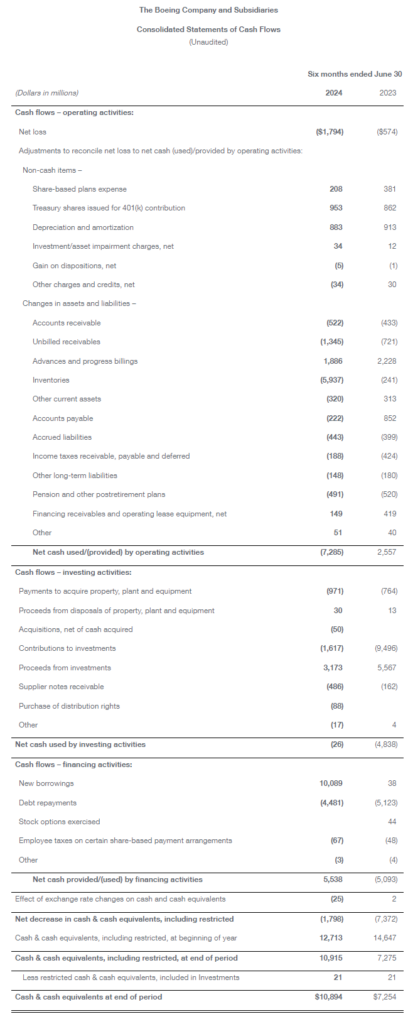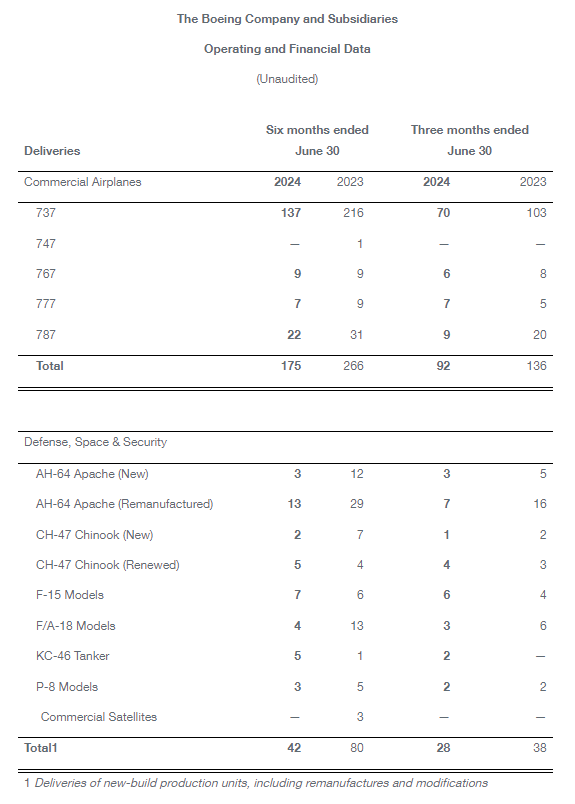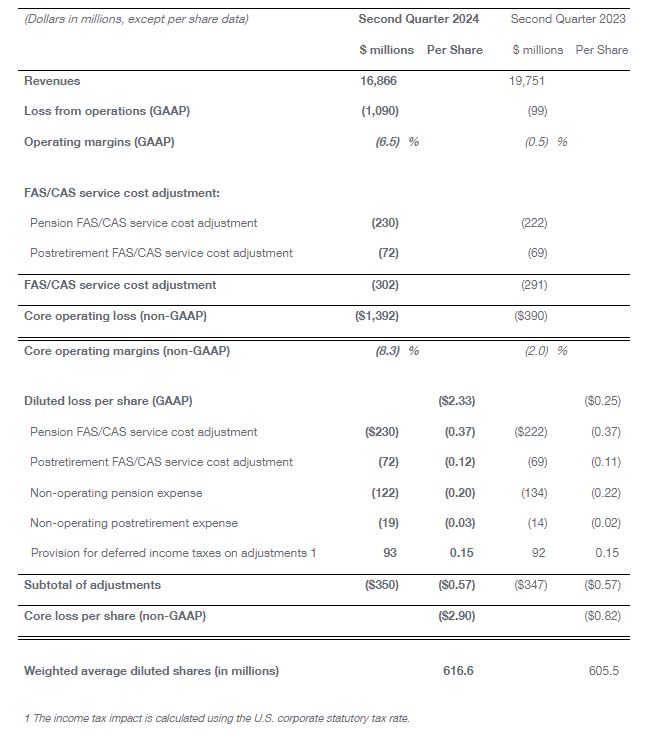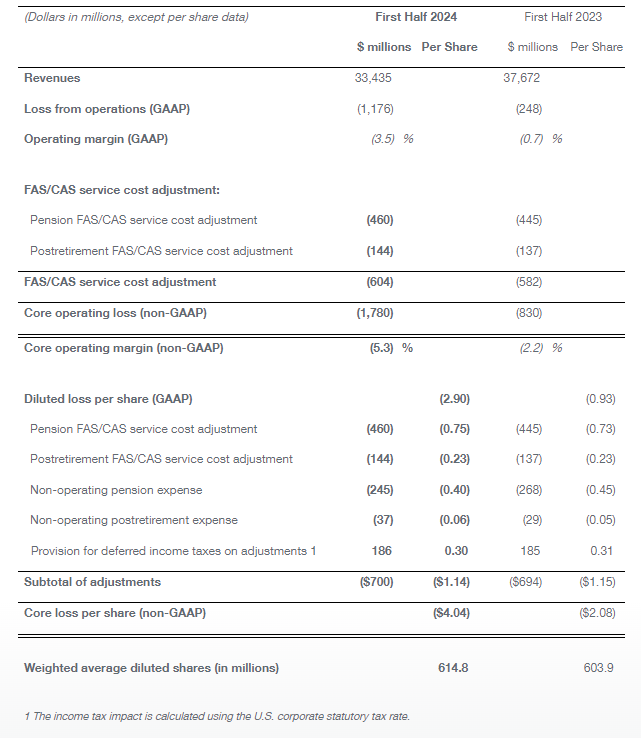ARLINGTON, Va., July 31, 2024 /PRNewswire/ —
Second Quarter 2024
- Submitted comprehensive safety and quality plan to the Federal Aviation Administration
- Announced agreement to acquire Spirit AeroSystems in July; transaction expected to close mid-2025
- Revenue of $16.9 billion, GAAP loss per share of ($2.33) and core (non-GAAP)* loss per share of ($2.90)
- Operating cash flow of ($3.9) billion and free cash flow of ($4.3) billion (non-GAAP)*
- Total company backlog of $516 billion, including over 5,400 commercial airplanes

*Non-GAAP measure; complete definitions of Boeing's non-GAAP measures are on page 5, “Non-GAAP Measures Disclosures.”
The Boeing Company [NYSE: BA] recorded second quarter revenue of $16.9 billion, GAAP loss per share of ($2.33) and core loss per share (non-GAAP)* of ($2.90) (Table 1). Boeing reported operating cash flow of ($3.9) billion and free cash flow of ($4.3) billion (non-GAAP)*. Results primarily reflect lower commercial delivery volume and losses on fixed-price defense development programs.
“Despite a challenging quarter, we are making substantial progress strengthening our quality management system and positioning our company for the future,” said Dave Calhoun, Boeing president and chief executive officer. “We are executing on our comprehensive safety and quality plan and have reached an agreement to acquire Spirit AeroSystems. While we have more work ahead, the steps we're taking will help stabilize our operations and ensure Boeing is the company the world needs it to be. We are making important progress in our recovery and will continue to build trust through action and transparency.”

*Non-GAAP measure; complete definitions of Boeing's non-GAAP measures are on page 5, “Non-GAAP Measures Disclosures.”
Operating cash flow was ($3.9) billion in the quarter reflecting lower commercial deliveries, as well as unfavorable working capital timing (Table 2).

1 Marketable securities consist primarily of time deposits due within one year classified as “short-term investments.”
Cash and investments in marketable securities totaled $12.6 billion, compared to $7.5 billion at the beginning of the quarter driven by the $10.0 billion issuance of new debt partially offset by the usage of free cash flow in the quarter (Table 3). Debt was $57.9 billion, up from $47.9 billion at the beginning of the quarter due to the issuance of new debt. The company has access to credit facilities of $10.0 billion, which remain undrawn.
Total company backlog at quarter end was $516 billion.
Segment Results
Commercial Airplanes

Commercial Airplanes second quarter revenue of $6.0 billion and operating margin of (11.9) percent primarily reflect lower deliveries and planned higher period costs, including research and development (Table 4).
During the quarter, the company submitted its comprehensive safety and quality plan to the Federal Aviation Administration (FAA). The 737 program gradually increased production during the quarter and still plans to increase production to 38 per month by year end. The 787 program maintains plans to return to 5 per month by year end. In July, the company announced an agreement to acquire Spirit AeroSystems, and the 777X program began FAA certification flight testing after obtaining type inspection authorization.
Commercial Airplanes delivered 92 airplanes during the quarter and backlog included over 5,400 airplanes valued at $437 billion.
Defense, Space & Security

Defense, Space & Security second quarter revenue was $6.0 billion. Second quarter operating margin of (15.2) percent primarily reflects $1.0 billion of losses on certain fixed-price development programs, including a $391 million loss on the KC-46A program largely driven by a slowdown of commercial production and supply chain constraints. Losses recorded on the T-7A, VC-25B, and Commercial Crew programs reflect higher estimated engineering and manufacturing costs, as well as technical challenges.
During the quarter, Defense, Space & Security captured an award for seven MH-139A helicopters from the U.S. Air Force and delivered the first CH-47F Block II Chinook to the U.S. Army. Backlog at Defense, Space & Security was $59 billion, of which 31 percent represents orders from customers outside the U.S.
Global Services

Global Services second quarter revenue of $4.9 billion and operating margin of 17.8 percent reflect higher commercial volume and mix.
During the quarter, Global Services secured an Apache performance-based logistics contract from the U.S. Army and captured FliteDeck Pro service contracts with Hainan Airlines and Ryanair.
Additional Financial Information

Other unallocated items and eliminations include an earnings charge of $244 million that reflects a fine that would be paid to the U.S. Department of Justice pursuant to an agreement that was recently filed in federal district court, if the agreement is approved.
Non-GAAP Measures Disclosures
We supplement the reporting of our financial information determined under Generally Accepted Accounting Principles in the United States of America (GAAP) with certain non-GAAP financial information. The non-GAAP financial information presented excludes certain significant items that may not be indicative of, or are unrelated to, results from our ongoing business operations. We believe that these non-GAAP measures provide investors with additional insight into the company's ongoing business performance. These non-GAAP measures should not be considered in isolation or as a substitute for the related GAAP measures, and other companies may define such measures differently. We encourage investors to review our financial statements and publicly-filed reports in their entirety and not to rely on any single financial measure. The following definitions are provided:
Core Operating Earnings/(loss), Core Operating Margin and Core Earnings/(loss) Per Share
Core operating earnings/(loss) is defined as GAAP Earnings/(loss) from operations excluding the FAS/CAS service cost adjustment. The FAS/CAS service cost adjustment represents the difference between the Financial Accounting Standards (FAS) pension and postretirement service costs calculated under GAAP and costs allocated to the business segments. Core operating margin is defined as Core operating earnings/(loss) expressed as a percentage of revenue. Core earnings/(loss) per share is defined as GAAP Diluted earnings/(loss) per share excluding the net earnings/(loss) per share impact of the FAS/CAS service cost adjustment and Non-operating pension and postretirement expenses. Non-operating pension and postretirement expenses represent the components of net periodic benefit costs other than service cost. Pension costs allocated to BDS and BGS businesses supporting government customers are computed in accordance with U.S. Government Cost Accounting Standards (CAS), which employ different actuarial assumptions and accounting conventions than GAAP. CAS costs are allocable to government contracts. Other postretirement benefit costs are allocated to all business segments based on CAS, which is generally based on benefits paid. Management uses core operating earnings/(loss), core operating margin and core earnings/(loss) per share for purposes of evaluating and forecasting underlying business performance. Management believes these core measures provide investors additional insights into operational performance as they exclude non-service pension and post-retirement costs, which primarily represent costs driven by market factors and costs not allocable to government contracts. A reconciliation of these non-GAAP measures to the most directly comparable GAAP measure is provided on page 12 and 13.
Free Cash Flow
Free cash flow is GAAP operating cash flow reduced by capital expenditures for property, plant and equipment. Management believes free cash flow provides investors with an important perspective on the cash available for shareholders, debt repayment, and acquisitions after making the capital investments required to support ongoing business operations and long term value creation. Free cash flow does not represent the residual cash flow available for discretionary expenditures as it excludes certain mandatory expenditures such as repayment of maturing debt. Management uses free cash flow as a measure to assess both business performance and overall liquidity. See Table 2 on page 2 for reconciliation of free cash flow to GAAP operating cash flow.
Caution Concerning Forward-Looking Statements
This press release contains “forward-looking statements” within the meaning of the Private Securities Litigation Reform Act of 1995. Words such as “may,” “should,” “expects,” “intends,” “projects,” “plans,” “believes,” “estimates,” “targets,” “anticipates,” and other similar words or expressions, or the negative thereof, generally can be used to help identify these forward-looking statements. Examples of forward-looking statements include statements relating to our future financial condition and operating results, as well as any other statement that does not directly relate to any historical or current fact. Forward-looking statements are based on expectations and assumptions that we believe to be reasonable when made, but that may not prove to be accurate. These statements are not guarantees and are subject to risks, uncertainties, and changes in circumstances that are difficult to predict. Many factors could cause actual results to differ materially and adversely from these forward-looking statements. Among these factors are risks related to: (1) general conditions in the economy and our industry, including those due to regulatory changes; (2) our reliance on our commercial airline customers; (3) the overall health of our aircraft production system, production quality issues, commercial airplane production rates, our ability to successfully develop and certify new aircraft or new derivative aircraft, and the ability of our aircraft to meet stringent performance and reliability standards; (4) our pending acquisition of Spirit AeroSystems Holdings, Inc. (Spirit), including the satisfaction of closing conditions in the expected timeframe or at all, (5) changing budget and appropriation levels and acquisition priorities of the U.S. government, as well as significant delays in U.S. government appropriations; (6) our dependence on our subcontractors and suppliers, as well as the availability of highly skilled labor and raw materials; (7) work stoppages or other labor disruptions; (8) competition within our markets; (9) our non-U.S. operations and sales to non-U.S. customers; (10) changes in accounting estimates; (11) realizing the anticipated benefits of mergers, acquisitions, joint ventures/strategic alliances or divestitures, including anticipated synergies and quality improvements related to our pending acquisition of Spirit; (12) our dependence on U.S. government contracts; (13) our reliance on fixed-price contracts; (14) our reliance on cost-type contracts; (15) contracts that include in-orbit incentive payments; (16) unauthorized access to our, our customers' and/or our suppliers' information and systems; (17) potential business disruptions, including threats to physical security or our information technology systems, extreme weather (including effects of climate change) or other acts of nature, and pandemics or other public health crises; (18) potential adverse developments in new or pending litigation and/or government inquiries or investigations; (19) potential environmental liabilities; (20) effects of climate change and legal, regulatory or market responses to such change; (21) credit rating agency actions and changes in our ability to obtain debt financing on commercially reasonable terms, at competitive rates and in sufficient amounts; (22) substantial pension and other postretirement benefit obligations; (23) the adequacy of our insurance coverage; and (24) customer and aircraft concentration in our customer financing portfolio.
Additional information concerning these and other factors can be found in our filings with the Securities and Exchange Commission, including our most recent Annual Report on Form 10-K, Quarterly Reports on Form 10-Q and Current Reports on Form 8-K. Any forward-looking statement speaks only as of the date on which it is made, and we assume no obligation to update or revise any forward-looking statement, whether as a result of new information, future events, or otherwise, except as required by law.
| Contact: | ||||||||
| Investor Relations: | Matt Welch or David Dufault BoeingInvestorRelations@boeing.com | |||||||
| Communications: | Michael Friedman media@boeing.com | |||||||




The Boeing Company and Subsidiaries
Reconciliation of Non-GAAP Measures
(Unaudited)
The tables provided below reconcile the non-GAAP financial measures Core operating loss, Core operating margin, and Core loss per share with the most directly comparable GAAP financial measures of Loss from operations, operating margin, and Diluted loss per share. See page 5 of this release for additional information on the use of these non-GAAP financial measures.

The Boeing Company and Subsidiaries
Reconciliation of Non-GAAP Measures
(Unaudited)
The tables provided below reconcile the non-GAAP financial measures core operating loss, core operating margin, and core loss per share with the most directly comparable GAAP financial measures, loss from operations, operating margin, and diluted loss per share. See page 5 of this release for additional information on the use of these non-GAAP financial measures.

Featured photo credit: Felipe Sanchez via Shutterstock



























































































































